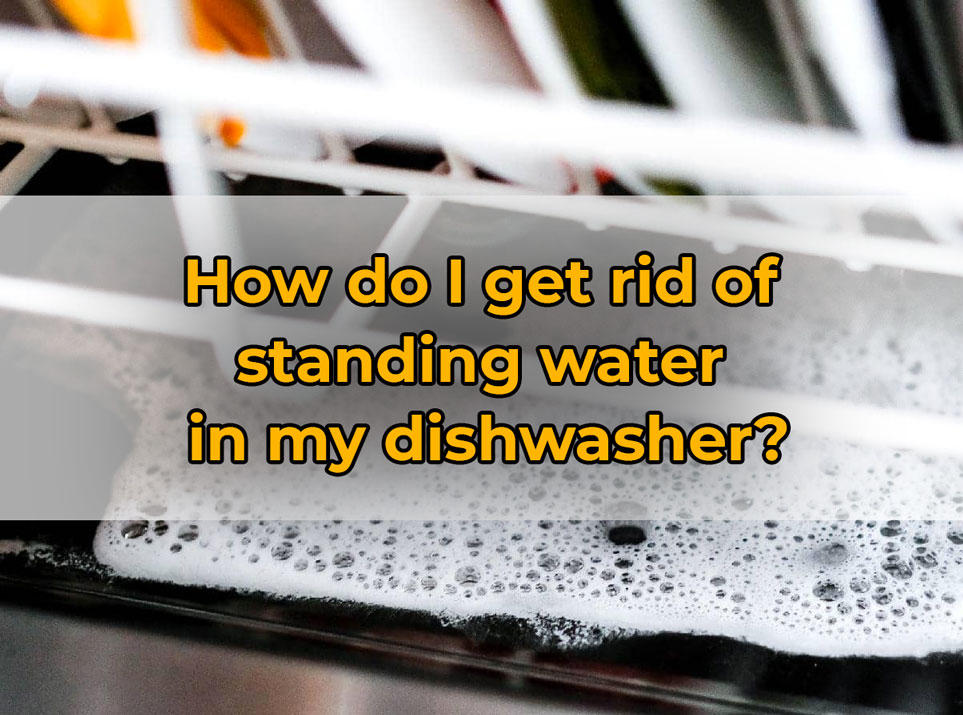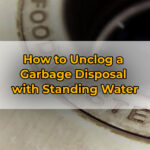Water in bottom of dishwasher when not in use is no fun. It’s important to know why it happens and how to fix it. A faulty water inlet valve or a clogged drain hose can be the cause. This can cause water to accumulate even when the dishwasher is not running.
But it can be more complicated. A float switch might be to blame too. The switch functions as a sensor that detects the water level. If it’s not working right, water could keep flowing into the dishwasher.
Here are some tips on troubleshooting this common problems:
Is it Normal to Have Water Left in dishwasher?

The answer is yes, it is completely normal for there to be some water left in the dishwasher. In fact, most dishwashers are designed this way to prevent any damage that could occur if the pump were to run dry.
The small amount of water left in the dishwasher serves a purpose. It acts as a seal or barrier between your dishes and the outside air, preventing any odors from seeping into your clean dishes.
Additionally, this residual water helps keep the rubber gaskets and seals in good condition by providing moisture and preventing them from drying out or cracking.
If you notice that there is an excessive amount of water remaining in your dishwasher after a cycle, then there may be an issue that needs attention.
Why Water in Bottom of Dishwasher When Not in Use?

If you notice water collecting in the bottom of your dishwasher when it’s not in use, there could be a few possible reasons for this issue:
1. Clogged Drain
One common culprit for this problem is a clogged drain. Over time, food particles and debris can accumulate in the drain, obstructing its proper functioning. As a result, water may remain stagnant in the dishwasher’s bottom even when it’s not being used.
A clogged drain prevents water from flowing out of the dishwasher effectively. When you run your dishwasher, any excess water should be drained out through the drain pipe.
However, if there’s a blockage impeding this process, the water will have nowhere to go but to settle at the bottom of the appliance. This stagnant water creates an ideal environment for bacteria growth and unpleasant odors to develop over time.
2. Faulty Check Valve
A check valve is an essential component that prevents water from flowing back into the dishwasher once it has drained. However, if this valve becomes defective or worn out, it can lead to water accumulation in the appliance.
When the dishwasher finishes its cycle and drains the dirty water, a properly functioning check valve should close tightly to prevent any backflow.
But if this valve fails to seal completely, it allows water from the sink drain or garbage disposal unit to seep back into the dishwasher.
As a result, every time you open your dishwasher door outside of a cleaning cycle, you may find an unwanted pool of water waiting for you at the bottom.
3. Malfunctioning Water Inlet Valve
This vital component controls the flow of water into your dishwasher, and if it becomes faulty, it can lead to unwanted leakage.
The water inlet valve is responsible for allowing water to enter the dishwasher during the wash cycle and shutting off the flow when not needed. However, over time, this valve can wear out or become clogged with debris such as mineral deposits or food particles.
When this happens, it may fail to close fully, causing a continuous trickle of water into the appliance even when it’s not running. As a result, you may find yourself dealing with a pool of stagnant water at the bottom of your dishwasher.
4. Improper Installation
One common installation mistake is failing to level the dishwasher properly. If your dishwasher is not level, water may accumulate at one end of the unit instead of draining properly.
To fix this issue, simply adjust the leveling feet until the appliance sits evenly on your kitchen floor. Another possible cause could be a loose or damaged drain hose connection.
If there are any leaks or gaps in the connection between your dishwasher and the drain system, water can leak out during cycles or when not in use.
How do I get rid of standing water in my dishwasher?

To get rid of standing water in your dishwasher, you can follow these steps:
1. Safety first
Before attempting any troubleshooting, make sure to turn off the power supply to the dishwasher. This typically involves either unplugging it from the electrical outlet or switching off the circuit breaker that powers the dishwasher.
2. Remove any excess water
The first step is to locate the drain filter or basket at the bottom of your dishwasher. This is where most debris and food particles tend to collect, causing blockages that prevent proper drainage.
Carefully remove the filter or basket and clean it thoroughly under running water, removing any visible buildup. You may also use a soft brush or toothbrush to scrub away stubborn residue.
Next, check for any clogs in the drain hose. Disconnect it from both ends (the dishwasher and garbage disposal/sink) and inspect for blockages.
3. Check for clogs
To start with, remove any dishes or utensils from the dishwasher and locate the drain at the bottom of the unit. Use a small cup or container to scoop out as much water as possible without causing a mess.
Next, take a closer look at the drain area and check for any visible debris like food particles or grease that might be obstructing its proper functioning.
Use a paper towel or an old toothbrush to gently clean these obstructions and ensure they don’t go further down into the drainpipes.
4. Clear the drain hose
To start, locate the drain hose at the back of your dishwasher. It is usually connected to either the sink or garbage disposal unit. Once located, carefully disconnect it from its source and place a bucket underneath to catch any excess water.
Next, inspect the hose for any clogs or blockages – often caused by food particles or debris that didn’t make it down the drain properly. Use a pipe cleaner or a long brush to remove any obstructions and ensure that the hose is clear.
5. Clean the filter
The first step is to clean the filter, which is often the culprit behind the issue. Start by removing any dishes or utensils from the dishwasher and locate the filter at the bottom of the unit. Gently twist and lift it out, being cautious as it may contain water or debris.
Once you have removed the filter, rinse it under running water to remove any food particles or residue that may be clogging it. Use a soft brush or toothbrush to scrub away stubborn grime if necessary.
Inspect both sides of the filter for any damage, such as cracks or breaks, which would require a replacement. After cleaning and ensuring its integrity, put the filter back in place securely.
6. Check the drain pump
The drain pump is responsible for removing water from your dishwasher after each cycle. If it gets clogged or malfunctions, standing water can accumulate in the bottom of your appliance.
To determine if the drain pump is causing the issue, start by disconnecting power to your dishwasher and turning off the water supply. Next, remove any dishes or debris from inside the dishwasher and locate the drain pump, which is typically found at the bottom of your appliance.
You may need to consult your owner’s manual for help in identifying its exact location.
Once you’ve located it, inspect for any visible blockages such as food particles or foreign objects that may be preventing proper drainage. Check also: Frigidaire Dishwasher Not Starting .
Prevent Water in Bottom of Dishwasher When Not in Use
To keep your dishwasher running smoothly, be sure to regularly clean the drain filter and check for blockages in the drain hose.
1. Clean the dishwasher regularly
Regular maintenance and cleaning are essential to prevent water buildup and keep your dishwasher running smoothly. By following a few simple steps, you can ensure that your dishwasher remains free from any lingering water.
2. Scrape dishes before loading
One simple yet effective step you can take is to scrape off any food debris from your dishes before loading them into the dishwasher. By doing so, you will prevent excess particles from clogging the drain and interfering with the proper drainage of water during each cycle.
When leftover food scraps are left on plates, bowls, or utensils, they have a tendency to break down and disintegrate during the wash cycle. This process releases tiny particles that can easily get trapped in the dishwasher’s filter or drain, leading to blockages that result in water accumulation.
By taking a few extra moments to thoroughly scrape off food residue before placing items in the dishwasher, you significantly reduce the risk of encountering this issue.
3. Rinse dishes lightly
Rinsing dishes lightly not only helps to maintain a clean dishwasher but also extends its lifespan. Excess food particles left on dishes can accumulate over time and form stubborn blockages within the dishwasher’s drain system.
As these blockages hinder proper water flow, they can cause backups that result in standing water at the bottom.
4. Run hot water before starting the dishwasher
The reason running hot water is crucial lies in how dishwashers operate. These appliances rely on hot water to effectively clean and sanitize your dishes.
However, if cold or lukewarm water is initially supplied to the dishwasher, it takes longer for it to heat up to the desired temperature during the wash cycle.
5. Use the appropriate dishwasher detergent
By selecting a detergent specifically designed for your machine and water type, you can ensure optimal cleaning performance and eliminate any chances of leftover water lingering at the bottom.
One important factor to consider is whether your water supply is hard or soft. Hard water contains higher levels of minerals such as calcium and magnesium, which can leave behind residue on dishes and inside your dishwasher.
Using a detergent formulated for hard water will help combat these mineral deposits, preventing them from settling at the bottom when not in use.
On the other hand, if you have soft water, using a regular dishwasher detergent will suffice without leaving any unwanted moisture or buildup.
6. Check the dishwasher’s drain and filter regularly
Regularly checking and cleaning these parts is crucial to prevent water from accumulating in your dishwasher. Not only can stagnant water lead to unpleasant odors, but it can also damage the internal components and affect the appliance’s performance.
To start, locate the drain and filter inside your dishwasher. These are usually found at the bottom of the unit. Remove any large debris like food scraps or utensils that may have gotten caught in these areas.
Next, carefully unscrew or detach the filter for thorough cleaning. Use a soft brush or sponge to remove any built-up residue that could be obstructing proper drainage. Rinse both the filter and drain with warm water to ensure they are entirely clear before reassembling them.
7. Address any plumbing issues
One effective way to prevent water from accumulating in the bottom of your dishwasher is to regularly inspect and clean the drain filter.
Over time, food particles, debris, and other grime can build up in this area, causing blockages that prevent water from draining properly.
To address this issue, remove the filter according to the manufacturer’s instructions and rinse it under running water to remove any residue. Check also: Maytag Centennial Washer Problems & Solving.
Do dishwashers drain automatically?
The answer is yes! Dishwashers are equipped with a built-in drainage system that efficiently removes the dirty water from the machine. Once the cleaning cycle is complete, dishwashers initiate the draining process, allowing the used water to flow out through a drain hose.
The draining mechanism in dishwashers operates on gravity and pressure principles. As soon as you press the “start” button on your dishwasher, it begins filling up with water through an inlet valve. During the wash cycle, jets spray hot soapy water onto your dishes for thorough cleaning. Once this process is done, it’s time for draining to take place automatically.
Can I force my dishwasher to drain?
The answer is yes, you can indeed force your dishwasher to drain. A clogged dishwasher drain can be a common issue due to food particles, grease, or debris accumulation. However, there are several methods you can try to resolve the problem on your own before calling in a professional.
Firstly, start by checking the filter and removing any visible blockages. Most dishwashers have filters located at the bottom of the unit that can easily be removed and cleaned.
Clearing out any debris from this area may allow water to flow freely through the drain again. If this doesn’t solve the issue, try pouring boiling water down the drainage pipe. This can help break up any greasy residue that may be causing blockages.
Is it wasteful to run dishwasher every night?
One key factor to consider when determining whether running the dishwasher every night is wasteful is the efficiency rating of your appliance. Older dishwashers tend to use more water and energy compared to newer models with higher efficiency ratings. If you have an older dishwasher, it may be more economical in terms of both resources and money to run full loads less frequently.
“There is no real ending. It’s just the place where you stop the story.”






